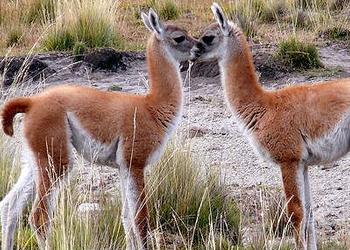
NEW YORK, New York, May 30, 2019 (ENS) – The largest protected area in Argentina’s Patagonian steppe, inhabited by wildlife such as the guanaco, the Andean cat, and Andean condor, has now been further secured by conservation groups that have arranged to buy the grazing rights on the reserve from livestock producers.

The Payunia Natural Protected Area in central-west Argentina’s Mendoza province was declared a nature preserve in 1988. Over 70 animal species that have adapted to its volcanic soil and arid climate have been documented in Payunia. As with most wild ungulates, guanacos compete for pasture with livestock.
The New York-based Wildlife Conservation Society, WCS, and Fundación Vida Silvestre Argentina, the associate organization in Argentina to the World Wide Fund for Nature, WWF, with funding from The Rainforest Site and GreaterGood.org, have negotiated the resignation of grazing rights from livestock producers for more than 43,500 acres in the Payunia reserve.
“By buying out the grazing rights from livestock producers we have reached an agreement with the Mendoza provincial government to incorporate these lands into the strictly protected core of the reserve,” said Carina Righi, director of WCS Argentina.
“Conservation of these nearly 43,570 acres is part of a long-term plan supported by GreaterGood.org and implemented by WCS and Vida Silvestre to conserve critical lands and wildlife species in Payunia,” Righi said.

The core protected area will safeguard the breeding range of a large migratory population of guanacos, allowing them to avoid competition with livestock for food and water in this arid environment. The guanaco, Lama guanicoe, is a camelid native to South America, closely related to the more familiar llama. While it is not in danger of extinction, the conservationists’ goal is to keep the Payunia population thriving.
“The consolidation of the core area of the Payunia, will be a substantial contribution to the conservation of emblematic and threatened species, and unique landscapes that shape the beauty and diversity of our country,” said Manuel Jaramillo, general director of Fundación Vida Silvestre Argentina.
The reserve contains one of the world’s highest concentrations of old volcanoes and is dominated by two volcanic mountains towering more than 3,500 meters above sea level. In the Payunia Reserve, the volcanic territory reaches its peak with a great variety of volcanic landforms that create a stunning landscape.
This land also protects habitat of the endangered Andean cat, recently discovered in this region. It provides a refuge from retaliatory killing by livestock producers for predation on their young goats.
In addition, this area is an important feeding ground for dozens of threatened Andean condors that roost in the surrounding mountains.
“When I visited the reserve area I was struck by the diversity and volume of animals, like an American Serengeti,” said Tim Kunin, CEO of GreaterGood.com, which operates The Rainforest Site.

Over the last 11 years, GreaterGood.org, a U.S.-based nonprofit, has given more than $175 million in cash and in-kind grants to some 3,000 charitable partners worldwide. The Rainforest Site, a GreaterGood Handmade project and one of the GreaterGood “click-to-give” sites, was established to protect vital habitats and endangered plants and animals.
In July 2018, the Mendoza provincial government signed an agreement with WCS Argentina and Vida Silvestre, committing to assign this area – and others soon to be purchased – to a stricter management category and to secure the long-term protection of the area.
The 43,570 acres of conserved habitat was already within the boundaries of the reserve but was being used by livestock producers who received the right to continue using the area from the province before the creation of the protected area.
Following the establishment of the reserve, the area was considered a sustainable management zone, which allowed livestock production.
“GreaterGood.org and our partners at The Rainforest Site are proud to fund this important conservation effort,” said Liz Baker, CEO of GreaterGood.org. “Thanks to WCS and Vida Silvestre, this important habitat has been secured for permanent protection – key to our mission to protect people, pets, and the planet.”
Copyright Environment News Service (ENS) 2019. All rights reserved.
© 2019, Environment News Service. All rights reserved. Content may be quoted only with proper attribution and a direct link to the original article. Full reproduction is prohibited.
